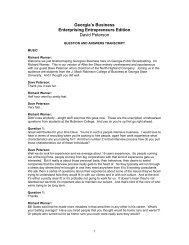PFOA stories
PFOA stories
PFOA stories
- No tags were found...
You also want an ePaper? Increase the reach of your titles
YUMPU automatically turns print PDFs into web optimized ePapers that Google loves.
But the agency's study noted that pesticides used in the area could be afactor. More study would be needed to rule it out, the study said.Also, the study noted the release into the area's air of the chemical1,3-butadiene, which has been associated with elevated cancer rates. TheGE Chemical plant in Wood County, located next door to DuPont, releases1,3-butadiene into the air, according to federal records.The DHHR study came to light only after a lawyer for Wood Countyresidents who drank C8-contaminated water discovered it in stateDepartment of Environmental Protection files and distributed it tovarious parties, including the Gazette.Jessica Greathouse, DEP's communications officer, said Tuesday that heragency "inadvertently disclosed" the draft report in response to aFreedom of Information Act request.But under state law, the basic facts of the study - including the cancerrate comparisons - would have to be released. Only commentary orrecommendations by the study's authors could be withheld.After the Gazette began asking questions about the DHHR study, DEPofficials contacted the residents' lawyer to try to retrieve thedocument and prevent its public disclosure.DHHR's Curtis said that she could think of no real harm that would havecome from releasing the study."I don't know that it would have hurt anything in retrospect," Curtissaid. "There was some talk about expanding it or looking at some otherinformation, but ultimately that was never completed."Study author Patricia Colsher said that she was waiting a year to addnew data - cancer rates from 2006 and for other counties affected by C8- to finalize the study."We did it, edited it, and then as the whole concern kind of expanded toother health outcomes and to other counties, we decided to hold off foranother year's data," Colsher said.With the 2006 data now available, she said, a final study could becompleted sometime later this year.One of Colsher's supervisors, state epidemiologist Loretta Haddy, agreedthat the plan was to add new data and publish the report.
















